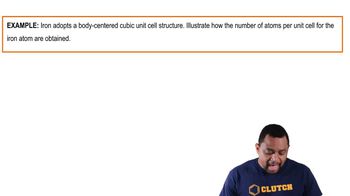Brass is a substitutional alloy consisting of a solution of copper and zinc. A particular sample of red brass consisting of 80.0 % Cu and 20.0 % Zn by mass has a density of 8750 kg/m3. (a) What is the molality of Zn in the solid solution?
During a person’s typical breathing cycle, the CO2 concentration in the expired air rises to a peak of 4.6% by volume. (b) What is the molarity of the CO2 in the expired air at its peak, assuming a body temperature of 37 °C?
 Verified step by step guidance
Verified step by step guidanceKey Concepts
Molarity

Ideal Gas Law

Body Temperature and Gas Behavior

Brass is a substitutional alloy consisting of a solution of copper and zinc. A particular sample of red brass consisting of 80.0 % Cu and 20.0 % Zn by mass has a density of 8750 kg/m3. (b) What is the molarity of Zn in the solution?
Caffeine (C8H10N4O2) is a stimulant found in coffee and tea. If a solution of caffeine in the solvent chloroform (CHCl3) has a concentration of 0.0500 m, calculate (b) the mole fraction of caffeine in the solution.
Breathing air that contains 4.0 % by volume CO2 over time causes rapid breathing, throbbing headache, and nausea, among other symptoms. What is the concentration of CO2 in such air in terms of (a) mol percentage,
Breathing air that contains 4.0 % by volume CO2 over time causes rapid breathing, throbbing headache, and nausea, among other symptoms. What is the concentration of CO2 in such air in terms of (b) molarity, assuming 1 atm pressure and a body temperature of 37 °C?
